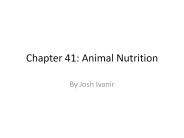Modes of Nutrition - PowerPoint PPT Presentation
1 / 29
Title:
Modes of Nutrition
Description:
Modes of Nutrition Nutrition Processes by which organisms obtain and use the nutrients required for maintaining life Modes of nutrition Ways of obtaining and using ... – PowerPoint PPT presentation
Number of Views:540
Avg rating:3.0/5.0
Title: Modes of Nutrition
1
Modes of Nutrition
2
Nutrition
- Processes by which organisms obtain and use the
nutrients required for maintaining life
3
Modes of nutrition
- Ways of obtaining and using nutrients
Nutrition
Autotrophic nutrition
Heterotrophic nutrition
Holozoic nutrition
Saprophytic nutrition
Parasitic nutrition
4
Autotrophic nutrition
- Organisms make their own food (complex organic
substances) using simple inorganic substances - Autotrophs
e.g. Green plants
by photosynthesis
5
Heterotrophic nutrition
- Organisms which depend on other organisms or dead
organic matters as their food sources - Heterotrophs
- Cannot make their own food and obtain their food
in organic form
6
Holozoic nutrition
- Organisms take in solid organic food from other
organisms - heterotrophs
Food needs to be broken down into small molecules
before they can be used by the organisms
7
Types of animals taking holozoic nutrition
- Herbivores
- Feed on plants only
Carnivores Feed on animals only
Omnivores Feed on both plants and animals
8
Saprophytic nutrition(Saprophytism)
- Organisms feed on dead organisms or non-living
organic matter - Saprophytes
- (e.g. fungi, bacteria)
9
How a saprophyte obtains its nutrients?
- Example Mucor (bread mould)
Rhizoids release enzyme into the bread
Enzymes digest complex organic molecules in bread
into simple, soluble molecules
Digested products are absorbed by the rhizoids
10
Importance of saprophytes
- As decomposers
- Allow essential materials (e.g. C, N) to be
recycled in the ecosystem
11
Parasitic nutrition(Parasitism)
- Organisms (parasite) obtain organic compounds
from another living organism of a different
species (host) - Parasite is benefited
- Host is harmed
12
How a tapeworm obtains its nutrient?
- Live inside the small intestine of human
- Food in small intestine is already digested
- ?Can be absorbed directly through the body wall
of tapeworm by diffusion
13
Structural adaptations of tapeworm
- Head bears hooks and suckers
- To attach itself to the intestine wall of the
host - ?Prevent being egested by peristalsis of intestine
14
Structural adaptations of tapeworm
- Long, flattened body
- To increase the surface area for more absorption
of digested food by diffusion - Thin body wall
- To shorten the distance for faster diffusion
15
Structural adaptations of tapeworm
- Body covered by cuticle
- To protect itself from attack of digestive
enzymes from the host - No mouth, digestive system
- No needed
- Hermaphrodite (bisexual)
- Need not find a mate for reproduction
16
Filter feeder
- Bivalves
17
Clam structures
18
Scallops structures
19
Carol
20
Rock feeder and filter feeder
21
Sand feeder
22
Insect and snail
23
(No Transcript)
24
Mosquito head
25
Mouth
26
Drilling
27
Filling up
28
Getting out
29
mararia































